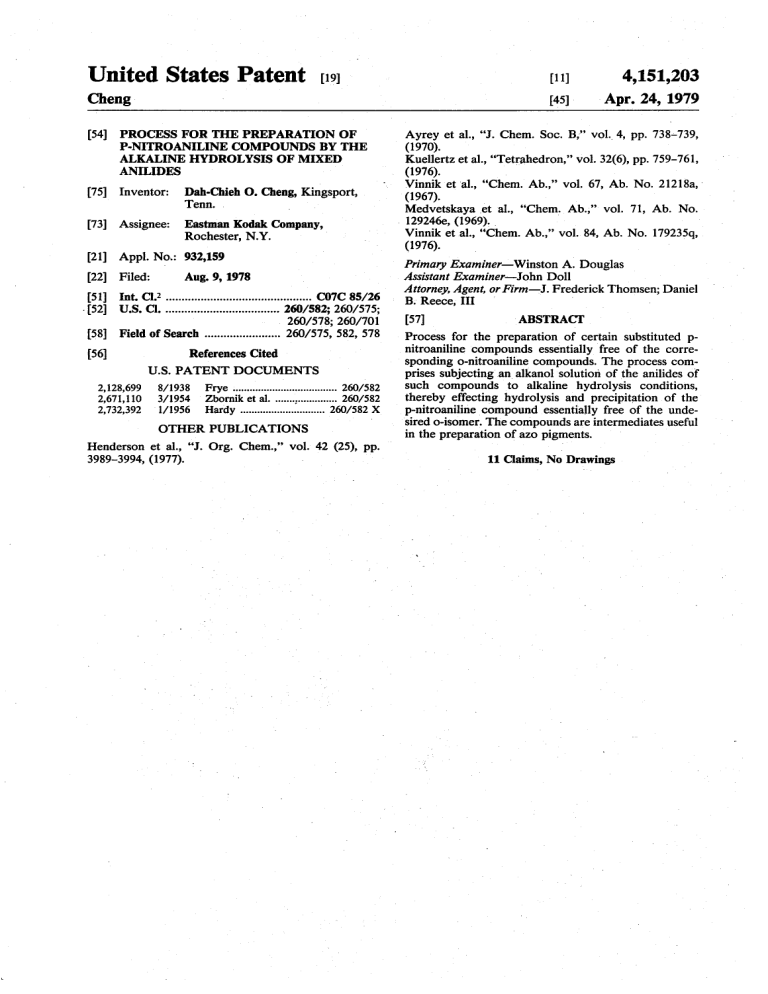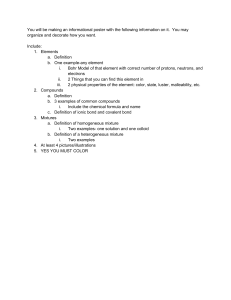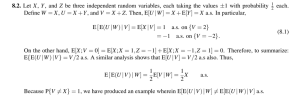
United States Patent (19) (11) 45 Cheng 4,151,203 Apr. 24, 1979 (54) PROCESS FOR THE PREPARATION OF Ayrey et al., "J. Chem. Soc. B," vol. 4, pp. 738-739, (1970). Kuellertz et al., “Tetrahedron,' vol. 32(6), pp. 759-761, (1976). 75 Inventor: Dah-Chieh O. Cheng, Kingsport, (1967). Medvetskaya et al., "Chem. Ab.," vol. 71, Ab. No. 129246e, (1969). Vinnik et al., "Chem. Ab.,' vol. 84, Ab. No. 179235q, (1976). Primary Examiner-Winston A. Douglas P-NTROANLINE COMPOUNDS BY THE ALKALINE HYDROLYSS OF MIXED ANLDES Tenn. 73 Assignee: Eastman Kodak Company, Rochester, N.Y. (21) Appl. No.: 932,159 22 Filed: Aug. 9, 1978 51 int. C.’.............................................. CO7C 85/26 :52 U.S. C. .................................... 260/582; 260/575; 260/578; 260/701 58 Field of Search ........................ 260/.575,582, 578 56) 2,128,699 2,671,110 2,732,392 References Cited U.S. PATENT DOCUMENTS 8/1938 Frye ..................................... 260/582 3/1954 Zbornik et al. . ... 260/582 1/1956 Hardy .............. ... 260/582 X OTHER PUBLICATIONS Henderson et al., "J. Org. Chem,' vol. 42 (25), pp. 3989-3994, (1977). Vinnik et al., "Chem. Ab.,' vol. 67, Ab. No. 21218a, Assistant Examiner-John Doll Attorney, Agent, or Firm-J. Frederick Thomsen; Daniel B. Reece, III 57 ABSTRACT Process for the preparation of certain substituted p nitroaniline compounds essentially free of the corre sponding o-nitroaniline compounds. The process com prises subjecting an alkanol solution of the anilides of such compounds to alkaline hydrolysis conditions, thereby effecting hydrolysis and precipitation of the p-nitroaniline compound essentially free of the unde sired o-isomer. The compounds are intermediates useful in the preparation of azo pigments, 11 Claims, No Drawings 4,151,203 1. PROCESS FOR THE PREPARATION OF P-NITROANILINE COMPOUNDS BY THE ALKALINE HYDROLYSS OF MIXED ANILDES 5 This invention concerns an improved process for the preparation of p-nitroanilines, the benzene ring of p-nitroanilides in an essentially pure form. The process of my invention for preparing p-nitroani line I in an essentially pure form comprises subjecting a lower alkanol solution of o-nitroacylanilide II and a lower carboxylic acid amide of I to alkaline hydrolysis conditions and separating insoluble I thus formed from the reaction medium, wherein I and II each is a com pound or an isomeric pair of compounds when X and Y are different having the formula diamine which is then reacted with diketene to form a 10 15 20 25 wherein Xishalogen, lower alkyl, or lower alkoxy; Y is lower alkyl or halogen; and R, R2 and Rare: I: R1 and R3 each is hydrogen and R2 is nitro; and II: R1 is nitro, R2 is hydrogen and R is lower carbox ylic acid acyl. The synthesis of compounds II and amides of com pounds I beginning with a X,Y-substituted benzene involves nitrating the benzene compound, hydrogenat ing the product to obtain the corresponding aniline compound which, after acylating the amino group, is then nitrated again. This reaction sequence is: 30 H2 I have discovered that if a mixture of compounds IV and V dissolved in an alcohol are subjected to alkaline 35 acy C H2SO4 G catalyst G anhydride G 45 Y 1,4-bis(acetoacetamido)-2,5-X,Y-benzene. The last mentioned compound can be employed as a coupling component in the synthesis of pigments, for example, by coupling with a diazotized aromatic amine to give a yellow pigment. The manufacture and use of these types of pigments are described German OLS Nos. 2,243,955, 2,244,035, 2,254,625, 2,312,734 and 2,326,298. It is known that the quality and performance of pig ments must be consistent and dependable and therefore the materials used in pigment production must not con tain impurities which affect the properties of the pig ment such as hue, color density and fastness properties. The use of compounds I as intermediates would not be desirable or feasible if such compounds contained signif. icant quantities of the corresponding o-nitroaniline compound. If a mixture of the compounds of formulas IV and V is subjected to acid hydrolysis conditions, both isomers are hydrolyzed to the corresponding ni troanilines. Separation of the p-nitroaniline from the o-nitroaniline has proved to be particularly difficult. For example, obtaining the desired compound in ac ceptable purity requires three or more recrystallizations from toluene. X HNO3 nitroanilides of formula IV are intermediates useful in . the preparation of azo pigments. For example, the p nitroaniline can be hydrogenated to the corresponding which contains, in addition to the amino and nitro groups, two substitutents. More particularly, this inven tion concerns a one-step technique for providing such 2 ents, such as in the case of p-chlorotoluene, formulas III, IV and V each represents an isomeric pair of com pounds, i.e., X= Cl, Y= CH3 and X = CH3, Y= Cl. The p-nitroaniline compounds I derived from p 50 hydrolysis conditions, IV is hydrolyzed to the p nitroaniline compound and can be precipitated from solution whereas V is unaffected by the conditions and remains in solution. My novel process thus not only accomplishes the necessary hydrolysis of the amide to the amine but very conveniently and economically pro vides the desired p-nitroaniline in an essentially pure form, i.e., essentially free of the o-nitroaniline. The alkaline hydrolysis conditions utilized in the practice of my novel process are well known and in clude the use of hydrolyzing-effective amounts of both water and a basic material such as the hydroxides of the alkali metals, for example, sodium and potassium. The use of sodium and potassium carbonate is not preferred since, in addition to hydrolyzing the p-nitroanilides, they cause precipitation of some of the o-nitroanilide. The amount of water employed can be widely varied provided there is at least a 1:1 stoichiometric ratio of water to the amide of I present. Generally the mol ratio of water to the amide of I will be in the range of about 55 X NH-acyl NH-acyl -- ON NO2 Y Y IV V As is shown, the second nitration results in nitration of the aromatic nucleus, with respect to the acylamide group, not only at the desired para position but also at the orthoposition. When X and Y are different substitu 65 2:1 to about 6:1 or more. The amount of basic material can be varied from about 1 to about 4 equivalents per equivalent of the amide of I. However, the use of 1 equivalent of basic material generally requires pro longed heating for completion of the hydrolysis whereas the use of amounts approaching 4 equivalents can render I soluble in the reaction medium and thus cause diminished yields. Preferably, potassium and/or sodium hydroxide are used in a ratio of about 1.5 to 2.5 moles per mole of the amide of I. Mol ratios of 1.8 to 2.0 are especially preferred. Usually the base employed is in the form of a concentrated aqueous solution such as, for example, a 50% solution (50 weight parts base and 50 weight parts water) and thus the amount of water em 3 4,151,203 4. illustration and are not intended to limit the scope of the ployed is dependent on the amount of the aqueous base invention. solution used. The alkanols which can be used are the common EXAMPLE 1. saturated alkanols containing up to about 4 carbons such as methanol, ethanol, n-propanol, isopropanol, 5 A mixture of 5-chloro-2-methyl-4-nitroacetanilide, 6-chloro-2-meth n-butanol and isobutanol. Methanol is preferred since it 2-chloro-5-methyl-4-nitroacetanilide, and 3-chloro-6-methyl-2is the most economical. It is apparent that the minimum yl-2-nitroacetanilide (total anilide content of approximately amount of alkanol which is required is that amount nitroacetanilide 1.2 mol) was prepared from p-chlorotoluene by the which will dissolve the mixture of II and the amide of I, consecutive steps of nitration, hydrogenation, acetyla i.e., the mixture of the anilides of formulas IV and V. 10 tion and nitration. The water-wet mixture of anilides The upper limit of the amount of alkanol is not critical was refluxed C.) with stirring with 600 ml. meth to the practice of the invention. Amounts of 20 mol of anol, and 120(~70° ml. of a 50% sodium hydroxide solution alkanol per mole of the mixture of anilides has given weight parts sodium hydroxide and 50 weight parts satisfactory results. For practical reasons, mol ratios of (50 After refluxing for 30 minutes 850 ml. of hot alkanol to anilide mixture of about 5 to 15 are preferred. 15 water). water was added, the mixture was again refluxed for 15 The temperature can be varied from about 25 to 125 and then cooled to room temperature. The C., although at lower temperatures the rate of hydroly minutes precipitate was filtered off and washed twice sis is relatively slow. The practical upper limit on the yellow with 600 ml. water. The water-wet product consisting temperature will be dependent on the constituents of 0 of 5-chloro-2-methyl-4-nitroaniline and 2-chloro-5the reaction mixture, i.e., the alkanol or alkanols used 2 methyl-4-nitroaniline was then hydrogenated to give and the relative amounts of alkanol and water. Most 1,4-diamino-2-chloro-5-methylbenzene. conveniently, the process is carried out at, or moder EXAMPLE 2 ately below, e.g., 5-10 C., the reflux temperature of the reaction mixture. Thus, the preferred temperature 25 A mixture of 2,5-dichloro-4-nitroacetanilide and 3,6when methanol is used is about 60 to 70° C. dichloro-2-nitroacetanilide (total anilide content of 0.05 To insure maximum precipitation of I and to provide mol) was prepared by the nitration of 0.05 mol of 2,5a workable mixture of solid I and the water-alkanol dichloroacetanilide. The water-wet mixture of anilides mixture, additional water is added to the mixture after I was dissolved in 20 ml. of methanol and 20 ml. of a begins to precipitate. The amount of water added will 30 solution consisting of 88 g. potassium hydroxide, 63 ml. be determined by practical considerations and is not water and sufficient methanol to a total volume of 250 critical. Generally, good results are achieved by adding ml. The solution was refluxed on a steam bath for 15 about 50 to 200 volume percent based on the volume of minutes, diluted with 50 ml. hot water and heated an the starting reaction mixture. Precipitation, of course, is additional 15 minutes. After cooling to room tempera maximized by cooling the reaction mixture, for exam- 3.5 ture the product was filtered and dried to give 8.8 g. ple, to room (or ambient) temperature. product, NMR analysis indicated the product was pure The above-described alkaline or based-catalyzed hy 2,5-dichloro-4-nitroaniline. drolysis conditions, as has been mentioned previously, EXAMPLE 3 are conventional and thus are well known to organic chemists. 40 A mixture of the anilide isomers (0.2 mol), prepared The carboxylic acid acyl residue of II and the amides as described in Example 1, in 100 ml. of methanol and 20 of I, i.e., the anilides of formulas IV and V, can contain ml. of 50% aqueous sodium hydroxide was refluxed for from 2 to 4 carbon atoms and include acetyl, propionyl, 20 minutes, an additional 140 ml. of hot water was butyryl and isobutyryl. Because of the availability and added and the mixture refluxed another 15 minutes. cost of acetic anhydride, acetyl is the preferred acyl 45 After cooling, the product was washed with water, residue in which case the mixture of anilides used in my filtered and dried to give 26.2 g of essentially pure novel process consists of a p-nitroacetanilide and an 5-chloro-2-methyl-4-nitroaniline and 2-chloro-5-meth o-nitroacetanilide. Chlorine, bromine, methyl, ethyl, yl-4-nitroaniline. Acidification of the filtrate gave 10.3 propyl, n-butyl, isobutyl, methoxy, ethoxy, propoxy g. of the corresponding 2-nitroacetanilide compounds. and butoxy are examples of the substituents represented 50 EXAMPLE 4 by X and Y. Chlorine, methyl and methoxy are pre A mixture of 2,5-dimethyl-4-nitroacetanilide and 3,6ferred substituents. The process of my invention is espe cially useful in preparing p-nitroaniline compounds dimethyl-2-nitroacetanilide was prepared by the nitra wherein X and Y each is methyl; X and Y each is tion of 0.2 mol of 2,5-dimethylacetanilide. A solution of chloro; X is chloro and Y is methyl (or v.v.); or X is 55 a portion of the water-wet mixture (total weight of 19 g.) in 40 mol methanol was refluxed for 15 minutes with methyl and X is methoxy (or v.v.). The solid I which is produced according to the inven 50% sodium hydroxide solution. To the reaction mix tion can be separated by conventional means such as, ture was added 50 ml. of hot water followed by reflux for example, by filtering or by centrifuging. As men ing. Upon cooling 7.5 g. of 2,5-dimethyl-4-nitroaniline tioned hereinabove, the p-nitroaniline compounds ob- 60 was recovered. Using essentially the same procedure tained can be hydrogenated to form the corresponding but substituting isopropanol for the methanol, a second 1,4-phenylenediamines which can then be reacted with 19 g. portion of the acetanilide mixture gave 5 g. of diketene to give 1,4-bis(acetoacetamido)benzene com 2,5-dimethyl-4-nitroaniline. pounds which are useful as couplers in the preparation of azo pigments. The invention will be further illustrated by the fol lowing examples although it will be understood that these examples are included merely for purposes of 65 EXAMPLE 5 A mixture of 2-methoxy-5-methyl-4-nitroacetanilide and 3-methyl-6-methoxy-2-nitroacetanilide (prepared by nitrating 0.1 mol of 2-methoxy-5-methylacetanilide) 4,151,203 5 6 was dissolved in 30 ml. methanol and 10 ml. of 50% X sodium hydroxide solution. The solution was refluxed NHR3 for 15 minutes, 50 ml. of hot water was added and stir ring was continued for 15 minutes. The reaction mixture 5 R2 R1 was cooled to room temperature, the precipitate filtered off and washed with water to give 17 g of 2-methoxy-5methyl-4-nitroaniline. NMR analysis indicated that the product was free of the isomeric 2-nitroaniline com pound. The invention has been described in detail with par ticular reference to certain preferred embodiments thereof, but it will be understood that variations and Y 10 15 modifications can be effected within the spirit and scope wherein X is chloro, methyl or methoxy; y is chloro or methyl; and R, R2 and R3 in the compounds or isomeric mixtures I and II are: I: R and Rare hydrogen and R2 is nitro; and II: R is nitro, R2 is hydrogen, and R3 is acetyl. 5. Process according to claim 4 wherein the hydro lyzing-effective amount of sodium hydroxide or potas sium hydroxide is from about 1.5 to 2.5 mol per mol of of the invention. I claim: the acetamide of I. droxide and separating insoluble I thus formed from the pair 6-chloro-3-methyl-2-nitroacetanilide and 3-chloro 6-methyl-2-nitroacetanilide. 8. Process for preparing I in an essentially pure form which comprises heating at a temperature of about 60' 6. Process according to claim 5 wherein I is 2,5dichloro-4-nitroaniline and II is 3,6-dichloro-21. Process for preparing I in an essentially pure form 2 nitroacetanilide. which comprises subjecting a lower alkanol solution of 7. Process according to claim 5 wherein I is the iso II and a lower carboxylic acid amide of I to hydrolysis meric pair 5-chloro-2-methyl-4-nitroaniline and 2 conditions in the presence of sodium or potassium hy chloro-5-methyl-4-nitroaniline and II is the isomeric reaction mixture, wherein I and II each is a compound or, when X and Y are different, an isomeric pair of compounds, having the formula to 70° C. a methanol solution of II and the acetamide of 30 X NHR 35 I in the presence of about 1.8 to 2.0 mol of sodium hydroxide or potassium hydroxide per mol of the acet amide of I and a hydrolyzing-effective amount of water, adding a second portion of water to complete precipita tion of I and separating I from the reaction medium, wherein I and II each is a compound or, when X and Y are different, an isomeric pair of compounds, having the formula wherein X is halogen, lower alkyl or lower alkoxy; Y is halogen or lower alkyl; and R, R2 and R3 in the com 40 pounds or isomeric.mixtures I and II are: I: R1 and Rhydrogen and R2 is nitro; and II: R is nitro, R2 is hydrogen, and R is lower carbox ylic acid acyl. 45 2. Process according to claim 1 which comprises heating a lower alkanol solution of II and an amide of I in the presence of water and a hydrolyzing effective amount of sodium hydroxide or potassium hydroxide. 50 3. Process of claim 2 wherein X is chloro, methyl or methoxy and Y is chloro or methyl. 4. Process for preparing I in an essentially pure form which comprises heating a methanol solution of II and the acetamide of I in the presence of a hydrolyzing effective amount of water and sodium hydroxide or NHR3 wherein X is chloro, methyl or methoxy; Y is chloro or methyl; and R, R2 and Rin the compounds or isomeric mixtures I and II are: I: R and Rare hydrogen and R2 is nitro; and II: R is nitro, R2 is hydrogen, and R3 is acetyl. 9. Process according to claim 8 wherein the mol ratio of alkanol to the total of mols of II and the amide of is about 5 to 15. 10. Process according to claim 9 wherein I is 2,555 dichloro-4-nitroaniline and II is 3,6-dichloro-2nitroacetanilide. 11. Process according to claim 9 wherein I is the isomeric pair 5-chloro-2-methyl-4-nitroaniline and 2 chloro-5-methyl-4-nitroaniline and II is the isomeric pair 6-chloro-3-methyl-2-nitroacetanilide and 3-chloro potassium hydroxide and separating insoluble I thus formed from the reaction medium, wherein I and II 6-methyl-2-nitroacetanilide. each is a compound or, when X and Y are different, an isomeric pair of compounds, having the formula 65




